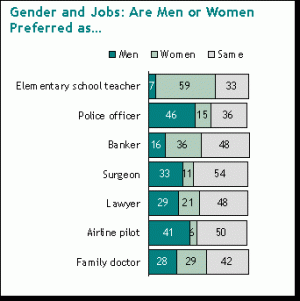MenTeach: There is much debate about what occupations men and women should have. In a study by Pew Research a survey shows there is bias towards one gender for specific occupations.
“…the survey asked whether people are more comfortable dealing with a man or with a woman in a variety of positions of authority – doctor, banker, lawyer, police officer, airline pilot, school teacher and surgeon.
Public attitudes are mixed. Among respondents who have a preference, men are favored in some roles (airline pilot, surgeon, police officer, lawyer); women in others (elementary school teacher, banker); and the public is evenly divided about whether its family doctor should be a man or a woman. Notably, however, for all seven of these positions, a sizable share of the public says it has no gender preference – ranging from the 33% who say this about teachers to the 54% who say it about surgeons.
Taken together, these results complement earlier findings from a wide-ranging Pew survey that explored public attitudes toward men and women as political leaders, and examined the roles that a candidate’s gender and parenthood status play in voters’ decisions
While many Americans say it makes no difference to them whether they deal with a man or woman in a range of high-profile positions of authority, the survey finds that they retain strong traditional gender preferences in a few positions, including elementary school teacher and police officer. The other positions tested were banker, surgeon, lawyer, airline pilot and family doctor. Here is a rundown of the public’s responses, based on interviews with the full sample of 2,250 adults.
Traditional roles
Most of the nation’s elementary school teachers are female, most police officers are male, and Americans generally prefer it that way. This attitude is especially prevalent when it comes to elementary school teachers; majorities of both genders and all race and age groups say they would rather deal with a woman than a man in that role.”
[MenTeach: The interesting part of the surgey is how you interpret the data. For example: The report focuses on women being preferred as elementary teachers. But consider that 7% of people surveyed are saying that they actualy prefer men to be their elementary school teacher. Even though 59% prefer women there are the 33% of people saying it can be a man or woman. It would have been interesting to know what the historical preferences were to compare them to now.]

